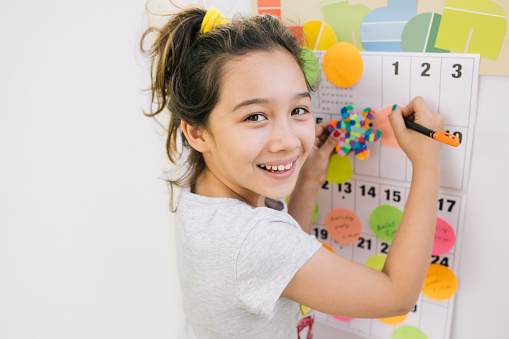For most of us, life feels anything but normal right now with the COVID-19 pandemic, schools closed and working from home. But you can create a new normal for your family by having consistent routines. It’s time for new routines!
Children thrive on routines. To little ones, there is so much new in their worlds, their brains and their bodies every day that making things predictable is reassuring. Kids need that reassurance now more than ever.
With many schools cancelled and people limiting their exposure to others, it’s up to us as parents to make new routines so our children feel safe and cared for. Those routines are probably going to look different than what we’re used to, but that’s okay. We just need to make them consistent.
Here are some suggestions of how to make a new routine for your weekdays. (I recommend keeping weekends looser, just like we do in other times.)
Set a school day schedule.
Keep it as close to your child’s normal school schedule as possible. If your child is not yet in school, create blocks of time during the day for certain types of activities. Young kids love to “play school,” and this is a great time to get them in a habit of a routine!
If your kids are in grade school or older, set up specific times for reading, math and other academic work, as well as breaks. They’ll be more cooperative and work harder if they know when they’re expected to work and for how long. Ask your child or her teacher how long their subject periods usually last—you might even find it on the school website. Consider using a timer (for example, thirty minutes for each subject), to cut down on the “When can I be done?” questions.
Learn from the world around you.
Many schools are sending work or providing guidance about what kind of work to do. But if you’re not sure what to do, have your kids READ READ READ! Use your environment. Go for a “nature walk” (even if you live in the city) and point out what you see. Encourage your kids to make games out of reading labels and counting objects in your home. You might be surprised at what they come up with.
Build specific time in the schedule for special subjects like movement, art and music. You do not need to be an expert at these things. Art can be drawing with a pencil or building a structure with sticks. Music can be singing together (off-key is fine!) or drumming a rhythm on the table for your child to repeat back to you. Movement can be making up your own dance, like Pinkalicious. Don’t worry—your child will come up with his or her own ideas, too!
Schedule two or three times a day to get outside.
Be physically active! It’s important for staying healthy, it’s a great stress reliever, it helps us focus when we get back to work, and it makes it easier to sleep at night.
Unfortunately, a lot of what kids like to do outside is off-limits right now because it involves getting close to other people, like climbing on playground equipment and playing soccer together. Instead, try going for a family walk or challenge each other to skip, hop and jump as many times as you can. Ride bikes or scooters. Do simple exercises like jumping jacks or more complex moves like cartwheels.
If you can’t get outside, or you live in a place where you can’t be at a safe distance from others outside, play physical games indoors, like Simon Says, Freeze Dance, or Red Light, Green Light. And who doesn’t love to have a dance party in the kitchen? Also consider virtual playdates with friends and family. It’s a great way to check in on each other during this time.
Set aside some quiet time.
Naps are still important for young kids. Older kids need some predictable downtime, too, especially in a stressful and uncertain time like this. You can find lots of great free mindfulness apps and activities online or follow these loving-kindness meditation practices. And to go low-tech, keep a family journal or make a daily list of three things each of you is grateful for. Post them on the fridge or put them in a jar so you can revisit them when you’re feeling down or stressed.
Set scheduled mealtimes and snack times.
Giving in to the urge to eat all day long will just make you and your kids lethargic. And having set times gives everyone a break to look forward to.
Consider your needs as a parent, especially if you’re working from home.
If you’re working from home, it can be tricky with the kids around. Set up some expectations with your children about when you’ll be able to help and when you won’t. Build into the schedule some activities you know they’ll be able to do on their own (and yes, educational TV shows are okay!) Be patient with them and yourself while you’re getting into a groove. Your kids might struggle to be independent at first, especially if they’re excited to have you around 24/7, but they’ll gradually get used to it. You probably won’t be as productive as usual, and that’s okay.
Consider your own needs and build them into your schedule. Shower. Prioritize sleep. Plan time for each parent to have a few moments to themselves. I take a few minutes of leisure reading time during my kids’ reading time. My introverted husband tries to take some walks by himself to enjoy the quiet. Taking care of yourself will not only help you stay healthy, but it will keep you centered so you can take care of your kids.
Keep loose but predictable afternoon and evening schedules.
If you normally do a bath every two days, stay in that groove. If you have a limit on screen time on school days, stick to it, or if you want to expand it, do it in an intentional way so the kids know the rules. And seize the opportunity to do new things. Maybe you’ve always wanted to have family dinners, but work schedules prevented it. This is a great time to add that to your family routine.
Plan a routine you can stick to.
Of course, planning a new routine is easier than sticking to it. Here are some suggestions for making it actually work.
- Engage your child in making the schedule. This will help them buy into it. For example, my kids each chose which subject to start with and opted to alternate art and music every other day. Use this handy planner with your family to get started!
- Post your daily schedule, so everyone knows what to expect, and so you can point to it instead of answering constant questions about when something is going to happen. We posted ours on the fridge and plan to go over it while we eat breakfast.
- If you fall out of your schedule, don’t worry about it. Just reset and try again. Make adjustments if you need to. When our 10-year-old finished his math work early, we embraced his suggestion of free reading. When our 5-year-old, who doesn’t usually nap, fell asleep on the couch, we rolled with it.
Ease into your new routine.
The first few days are probably going to be rough but try to stick with it. Keep in mind that having a predictable schedule doesn’t mean you have to live by a rigid clock. In fact, this can be a good opportunity to loosen up some time limitations that have been stressing you out. In our house, we usually have to get four people out of the house by 7:15 a.m. every weekday morning. Now we’re enjoying letting the kids sleep until their bodies are ready to wake up.
Above all, as you navigate your new routine, try to cultivate patience, practice empathy for your kids and keep a sense of humor. This can be difficult in times of crisis, but it’s also more important than ever. Fortunately, kids give us lots of reasons to laugh. And those unpredictable moments can be just what we need to make our new routines work.
Suzanne Bouffard is a author, developmental psychologist and freelance writer who lives with her husband and two young children in Massachusetts.
This article was originally published on PBS.org/Parents.





